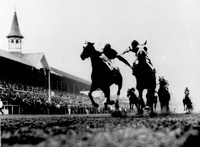Animal locomotion
EXHIBIT 16
The Royal Society's Summer Science Exhibition 2004
Dr Alan Wilson, Dr John Hutchinson, Dr Rachel Payne and Dr James Wakeling.
The Royal Veterinary College, University of London.
|
Whilst galloping, horses' legs spend 80% of the time off the ground. |
What limits the maximum gallop speed of a racehorse? The ability of animals, from an insect to a horse, man or dinosaur, to run fast is defined by physics and mechanics. From a mechanical point of view an animal's leg resembles a child's pogo stick, yet animals can run efficiently through a range of speeds and over a variety of terrains without bouncing.
This 'spring legged' gait is, however, inherently unstable and understanding how animals remain stable during motion is of interest both for its own sake and for the design of animal-inspired robots. Researchers at the Royal Veterinary College have developed equipment for studying animal motion literally 'in the field' (or indeed on the racetrack) with the aim of understanding the principles of each animal's system design for motion.
|
Modelling the forces needed for fast galloping: the mechanics of equine limb protraction with equine forelimb at 50%, 90% and 101% (protraction) of stance, taken from motion-analysis data. |
'The standard model for a racehorse is a man pushing a wheelbarrow', says Alan Wilson. 'The power is provided by the back legs and the front legs hold the animal up.' But it's more complex than that. Increasing power doesn't make a horse run faster. Using a combination of data collected from racehorses in training via global positioning systems and radio-linked sensors on the animals, plus computer simulation of horse locomotion, the team can show how a horse can gallop at over 40 mph, and which horse has the best potential to be a winner.
Horses actually fly more than run when they gallop, as their legs are off the ground for over 80% of the time. The muscular work of galloping horses is halved by storing and returning elastic strain energy in spring-like muscle-tendon units - the pogo stick mechanism - and is optimised to stretch and recoil at around 2.5 strides per second. The higher the frequency, the greater the speed.
A key ability for fast runners is to bring their legs forward for the next stance quickly in order to support their weight. This is a particular challenge for large animals with long limbs where muscles contract slowly and have a relatively low power output. 'Horses store energy in an elastic biceps muscle in the leg that releases energy to catapult the limb forward', explains Alan. 'This elastic muscle delivers an output comparable to over 100 times its mass of non-elastic muscle and this is the main generator of the force to move the leg forward.' This mechanism is similar to that used by grasshoppers and fleas to achieve their rapid accelerations.
With the pogo stick mechanism a horse has the potential to exert very large forces on the ground when its hooves hit the turf. So what actually limits the speed of a horse is its leg stiffness. This limits the amount of force that the leg can transmit to the ground without causing damage to the limb itself and also how quickly the horse can bounce back into the air.
The techniques used to study horses can be applied to other animals such as ostriches, camels and even dinosaurs. By measuring their limb size and using computer models it has been shown that T. rex could probably make a top speed of 16 mph - fast, but not fast enough to win the 4.10 at Epsom.
Trackback URL : 이 글에는 트랙백을 보낼 수 없습니다
Trackback RSS : http://www.fallight.com/rss/trackback/723
Trackback ATOM : http://www.fallight.com/atom/trackback/723







